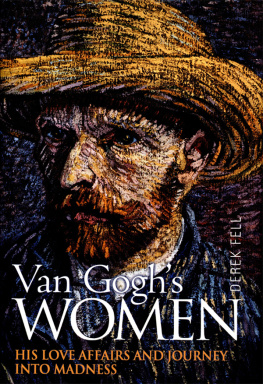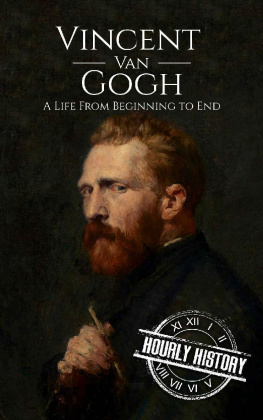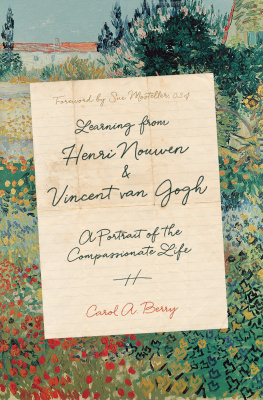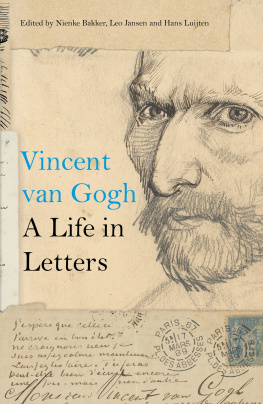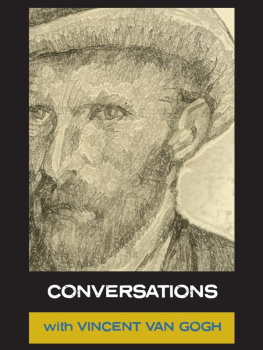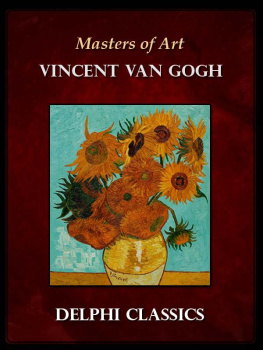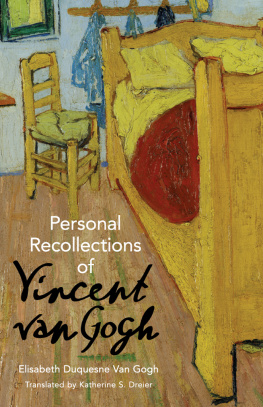Derek Fell - Van Goghs Women: His Love Affairs And Journey Into Madness
Here you can read online Derek Fell - Van Goghs Women: His Love Affairs And Journey Into Madness full text of the book (entire story) in english for free. Download pdf and epub, get meaning, cover and reviews about this ebook. year: 2015, publisher: Pavilion Books, genre: Non-fiction. Description of the work, (preface) as well as reviews are available. Best literature library LitArk.com created for fans of good reading and offers a wide selection of genres:
Romance novel
Science fiction
Adventure
Detective
Science
History
Home and family
Prose
Art
Politics
Computer
Non-fiction
Religion
Business
Children
Humor
Choose a favorite category and find really read worthwhile books. Enjoy immersion in the world of imagination, feel the emotions of the characters or learn something new for yourself, make an fascinating discovery.
- Book:Van Goghs Women: His Love Affairs And Journey Into Madness
- Author:
- Publisher:Pavilion Books
- Genre:
- Year:2015
- Rating:3 / 5
- Favourites:Add to favourites
- Your mark:
- 60
- 1
- 2
- 3
- 4
- 5
Van Goghs Women: His Love Affairs And Journey Into Madness: summary, description and annotation
We offer to read an annotation, description, summary or preface (depends on what the author of the book "Van Goghs Women: His Love Affairs And Journey Into Madness" wrote himself). If you haven't found the necessary information about the book — write in the comments, we will try to find it.
A revealing and moving life of Vincent van Gogh, his search for love and devastating romantic losses. Thwarted passion, romantic disappointment, madness, and the redemptive power of genius - a portrait of the artist that views Vincent van Gogh and his work boldly anew.
Derek Fell: author's other books
Who wrote Van Goghs Women: His Love Affairs And Journey Into Madness? Find out the surname, the name of the author of the book and a list of all author's works by series.
Van Goghs Women: His Love Affairs And Journey Into Madness — read online for free the complete book (whole text) full work
Below is the text of the book, divided by pages. System saving the place of the last page read, allows you to conveniently read the book "Van Goghs Women: His Love Affairs And Journey Into Madness" online for free, without having to search again every time where you left off. Put a bookmark, and you can go to the page where you finished reading at any time.
Font size:
Interval:
Bookmark:

OTHER BOOKS ON THE IMPRESSIONIST ERA BY DEREK FELL:
Renoirs Garden
The Impressionist Garden
Secrets of Monets Garden
Impressionist Bouquets
Impressionist Roses
Van Goghs Gardens
Czannes Garden

HIS LOVE AFFAIRS AND
JOURNEY INTO MADNESS
DEREK FELL

In memory of my mother,
Mary Woodhouse Fell (1917-2001)
M y investigation into Vincent van Goghs relationships with women was a lonely endeavour, spent mostly in libraries, where I read for long hours through a massive amount of fact, speculation, and comment. I was fortunate, though, to also enjoy the benefit of numerous expertsart historians, artists, psychologists, theologians, and the research staff at the Van Gogh Foundation, Amsterdam (whose helpfulness should not be considered an endorsement of this book, however)in dealing with the enormous number of contradictions and confusion about the artists life.
I value the support of my wife, Carolyn, on whom I first tested my theories of Vincents love, rejection, and suicide. She also accompanied me to Tahiti to help me research Vincents influence on Gauguins Tahitian paintings, since Gauguin went there within a year of Vincents death, to fulfill a promise to Vincent that he would.
I owe a huge debt of gratitude to Lawrence A. Decker, Ph.D., Doctor of Psychology, who read my initial draft and provided expert guidance in light of his experience and training as a specialist in family counseling. Dr. Decker served as a consultant on this project whenever psychological questions needed verification. (Dr. Decker received his doctorate from Brigham Young University and a Post-Doctoral Fellowship from the Menninger Foundation. He was formerly a Senior Vice President at Medco and a consultant to U.S. Healthcare.)
A special thanks to Adeline Vincotte, interpreter at the Office of Tourism dAuvers-sur-Oise, for providing access to the departments library and helping me tie together a number of loose ends concerning Vincents last days; and to my literary agent, Albert Zuckerman, who first sparked the idea of this book during a brainstorming session following publication of my earlier book Van Goghs Gardens.
Frances Fisher, an independent professional editor, was kind enough to read my initial draft and make many excellent suggestions for improvement. Terry Swaine, neurotherapist, contributed freely of his expertise. My editors at Carroll & Graf, Claiborne Hancock and Peter Skutches, also contributed greatly to the final result.
For a more detailed explanation of my indebtedness to Robert G. Harrison, of Montreal, for permission to use his copyrighted translation of Vincents letters, see the Copyrights page. He also played devils advocate during my research.
In the text, I have chosen to refer to Vincent van Gogh as Vincent rather than van Gogh, as he said in a letter to his brother from Arles: In future my name ought to be put in the catalog as I sign it on the canvas, Vincent, and not van Gogh.
The text refers to numerous works by Vincent, and though the most important of these are shown in a
I cannot live without love,
without a woman.
Vincent van Gogh
A woman is not old as long as she loves and is loved.
Letter to Theo, July 31, 1874,
from Vincents lodgings in London
I n the summer of 1890, an hour by train from the sweltering heat of Paris, the riverside village of Auvers-sur-Oise was a haven of gentle breezes, its cobbled streets cooled by the shade of weeping willows. Boathouse clubs fronted the river, where men in straw boaters and women in long gauzy white dresses lazily paddled its mirror-smooth surface. Along a ridge of wooded hills, farmworkers quaint thatched cottages contrasted with the new, architect-designed weekend residences of affluent Parisians, many of them Tudor-style timbered structures with orange pantile roofs.
This is where the visionary painters Charles Daubigny, Honor Daumier, and Camille Corotprecursors to the Impressionistshad lived and painted their romantic landscapes. The father of Impressionism, Camille Pissarro, still lived nearby in an apple orchard. A youthful Paul Czanne had lived in the village and studied under Pissarros tutelage. Claude Monet had only recently moved north to Giverny, where he established his house and garden.
In this painters paradise, even the sound of gunfire was little cause for alarm, as farmers with shotguns frequently protected their grain fields from marauding crows. Also, the hunting of small game was common among the locals.
And so, when the shimmering afternoon air of the amber wheat fields above the village was shattered by a single gunshot, nobody paid any attention. Nor did anyone notice the wounded man who stumbled downhill and staggered along a narrow back alley to his room at a tavern on the main avenue.
The man was 37-year-old Vincent van Gogh. A bullet was lodged against the wall of his stomach, and he was slowly dying with a smile on his face. When his landlord, Arthur Ravoux, spotted the trail of blood leading upstairs and found the painter curled up in a ball on his bed, he summoned Vincents doctor and brother. The life of a great artist, at the peak of his powers and on the verge of artistic recognition, was drawing to a close.
But why? What prompted this manso enthralled with his surroundings, so pleased at last with the progress of his art and his mental healthto shoot himself? The enigma has endured for more than a century. Only now, by examining Vincents relationships with the women in his turbulent life, is it possible to unravel the mystery.
Most people think of Vincent van Gogh as the brilliant but disturbed artist who sliced off his ear. A lunatic, we are inclined to believe. Certainly Vincents life was filled with contradictions, and today art historians, theologians, and psychologists continue to explore the perplexity of his genius, which was wrought out of a life marked by melodrama, bizarre love affairs, and mental anguish.
Vincent was born in the vicarage at Groot Zundert, a farming community in southern Holland, on March 30, 1853. For Europe this was a time of significant social change; in France it was known as la Belle Epoqueto signal a golden age of cultural and industrial development. The recent invention of the steam engine had made ships independent of the wind; railroads dramatically shortened travel time on land; and electric lighting became available to millions. Large cities saw the building of grand hotels, department stores, and wide boulevards. The opportunities for wealth were immense; across Europe and North America, industrialization spawned an affluent middle class with disposable income and leisure time. But the working class remained poor and continued to struggle against meager wages, job insecurity, and the need to work long hours to feed their families.
Born to middle-class Dutch parents, Vincent was the eldest of his siblings, three sisters and two brothers. He was not the firstborn, however; an older brother had died at birth. Vincents father, Theodorus, a Calvinist pastor, ran a strict, autocratic household in which the redheaded, freckle-faced Vincent fit uncomfortably. An intense, sullen child with low self-esteem, he was prone to temper tantrums. He walked around awkwardly, with his head bent low. A family servant described him as being aloof, ill-mannered, and having the disposition of an old man. Nepotism gained him his first jobas a clerk in an uncles art gallery in The Hague. He then moved to the firms London office as an art dealer and made a promising start there, until his love for his landladys daughter, Eugenie Loyer, was rejected. When she revealed that she was secretly engaged to a previous boarder, He tried everything to break this engagement, wrote his future sister-in-law, Johanna, but he did not succeed. This was the first in a series of disastrous romantic relationships that further damaged his already diminished sense of self-worth. With this first great sorrow, his character changed, Johanna wrote in a memoir. When he came home for the holidays he was thin, silent, dejecteda different being... he grew more and more silent and depressed, and also more and more religious.
Next pageFont size:
Interval:
Bookmark:
Similar books «Van Goghs Women: His Love Affairs And Journey Into Madness»
Look at similar books to Van Goghs Women: His Love Affairs And Journey Into Madness. We have selected literature similar in name and meaning in the hope of providing readers with more options to find new, interesting, not yet read works.
Discussion, reviews of the book Van Goghs Women: His Love Affairs And Journey Into Madness and just readers' own opinions. Leave your comments, write what you think about the work, its meaning or the main characters. Specify what exactly you liked and what you didn't like, and why you think so.

